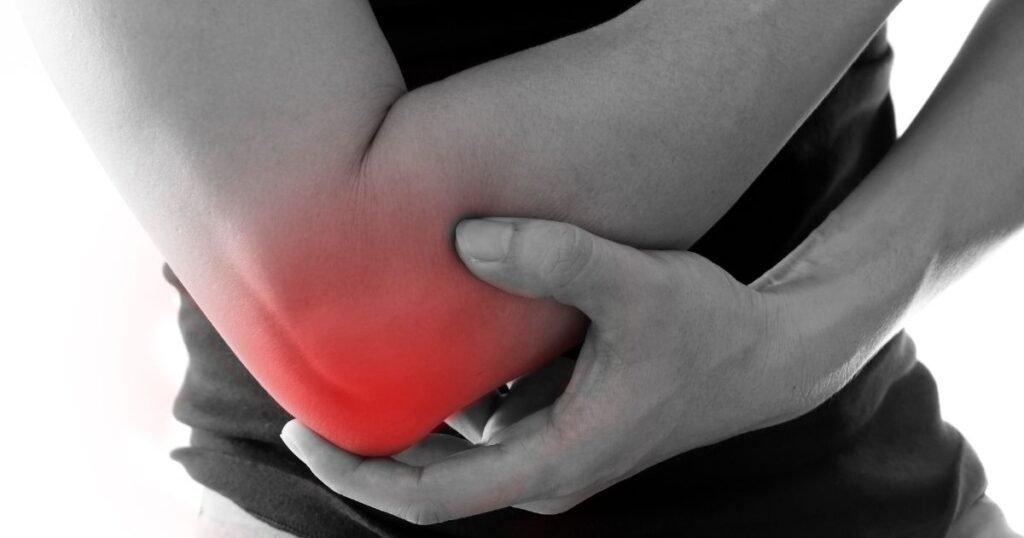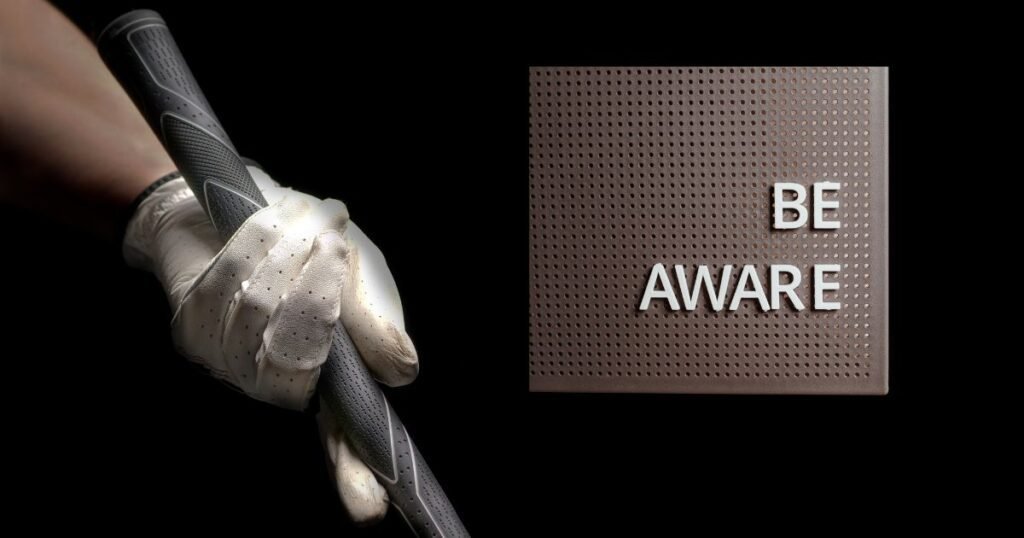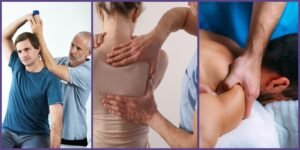Golf season has finally started, and if you’re like most weekend warriors, you’ve already dusted off the clubs and booked your first tee time. It’s exciting; sunny days, that satisfying sound of a clean hit, maybe even a cart beer or two. But here’s the thing most people forget: your body didn’t swing anything all winter.
And that first swing? It’s not always friendly.
A lot of golfers come into the season unprepared, especially when it comes to mobility and strength. The result? Injuries like golfer’s elbow sneak up fast, and that nagging pain on the inside of your elbow? It’s not something to shrug off.
This post isn’t just another “stretch before you play” lecture. We’re breaking down why these injuries happen when the golf season kicks off, how to spot them early, and what to do about them. From practical prevention tips to massage therapy and physiotherapy support, we’ve covered your swing (and your elbow).
Let’s talk about Golfer’s Elbow awareness, pain, prevention, and how you can enjoy the season pain-free.
What Is Golfer’s Elbow?
Most people think of golf as a low-impact, easygoing sport. And it is, until you’re three rounds in, your swing’s off, and your elbow starts talking back. That deep, nagging ache on the inside of your elbow? It’s a repetitive strain injury, and it doesn’t care whether you’re a scratch golfer or just out for the occasional round.
Golfer’s elbow happens when the tendons on the inside of your elbow get irritated from overuse. In golf, it usually shows up from gripping too hard, poor swing mechanics, or just doing too much too soon after a long off-season. And it’s not limited to golf, tennis, throwing sports, and even typing, which can trigger it. But for golfers, it’s especially common right when the season starts.
It’s a repetitive strain injury, and it doesn’t care whether you’re a scratch golfer or just out for the occasional round.
The pain usually starts mild, maybe it only shows up after a long round or when you grip your club a little tighter. But it can creep up fast if you ignore it. Eventually, it messes with your grip strength, your range of motion, and your ability to swing without wincing.
And here’s the kicker: most people wait too long to deal with it. By the time they show up for help, the elbow’s inflamed, mobility’s shot, and the season’s already in full swing.

Why Does It Happen More During the Golf Season?
There’s something about the first few weeks of golf season that gets people jumping in headfirst. You’ve waited months to hit the course, so when the weather finally cooperates, it’s go time. No warm-ups, no prep, just straight to full swings and 18 holes. That’s where the problems start.
During the off-season, your swing muscles go a little quiet. If you haven’t been doing anything to keep them active, and let’s be honest, most of us haven’t, your body isn’t ready for the sudden load. The elbow joint, especially the tendons on the inside, takes on a lot of stress from gripping, swinging, and repeating that same motion over and over.
And it’s not just the big hitters. Even casual golfers get hit with early-season aches. You might not even feel it during the game. It’s usually the next morning, when you reach for your coffee and your elbow gives you that “hey, not cool” kind of pain.
Add in a few back-to-back rounds, and suddenly that minor twinge becomes a real issue. The truth is, golfer’s elbow isn’t just about poor form or overplaying — it’s about doing too much too soon, especially when your body hasn’t had time to adjust. That’s why it spikes right when the golf season starts.
Spotting the Warning Signs Early
You don’t just wake up with full-blown golfer’s elbow one day. It creeps in (slowly at first) and if you know what to look for, you can catch it before it messes with your entire season.
What the Early Signs Look Like:
- A dull ache on the inside of your elbow (especially after a game)
- Stiffness when you first wake up or after resting
- Tightness or weakness when gripping your club
- Tingling or numbness down the forearm, sometimes into the fingers
- Pain that flares when you flex your wrist or make a fist
It may not scream injury at first, maybe it’s just a little annoying. But that’s the trap; we tend to play through it, hoping it’ll just go away. And in doing that, the tendon keeps getting irritated, which makes recovery longer and harder.
When to Take It Seriously:
If the pain is sticking around for more than a few days (or if it’s getting worse instead of better) it’s time to pump the brakes. Playing through it won’t make you tougher. It just makes the rehab process slower. And if you’re feeling it during everyday tasks (grabbing a mug, picking up a bag), it’s already past the “mild” stage.
Catching it early means you’ve got options, from rest to massage to active rehab, without having to sit out half the summer.
Preventing Golfer’s Elbow Before It Starts
The best way to deal with a golfer’s elbow? Don’t let it happen in the first place. Sounds obvious, right? But prevention isn’t just about stretching for five minutes before tee time. It’s about building habits that keep your muscles strong, mobile, and ready to handle the game.
Ease Into the Season (Seriously)
We get it: when the golf season is here, you want to play as much as you can. But going from zero to five rounds a week is asking for trouble. Start slow. One or two rounds a week in the beginning is more than enough. Give your body time to adapt.
Strengthen the Right Muscles
Golfer’s elbow happens because the tendons are doing more than they can handle. So give them some backup.
Here are a few exercises that help:
- Wrist curls and reverse wrist curls (light dumbbells do the trick)
- Forearm pronation/supination with a small weight or resistance band
- Grip squeezes using a tennis ball or a soft stress ball
- Eccentric wrist extensions (slow lowering phase is key here)
Doing these 2–3 times a week can build tendon strength and resilience, especially before you even hit the course.
Don’t Skip Mobility Work
Tight forearms? Stiff wrists? That all adds up over time. A few minutes of light stretching after each round can go a long way:
- Forearm flexor and extensor stretches
- Gentle wrist rolls
- Shoulder and upper back mobility drills
Simple stuff, but if you do it regularly, you’ll feel the difference.
Check Your Swing
Last one, and this one’s big. A poor swing technique (especially a strong grip or jerky follow-through) puts extra load on your elbow. If something feels “off” when you swing, don’t wait. Get it looked at. It might not be a huge issue now, but it could turn into one fast.
Golfer’s Elbow Treatment Options: How Physiotherapy Can Speed Up Recovery
Physiotherapy sounds like something only athletes or post-surgery patients need, but when it comes to golfer’s elbow, it’s one of the most practical tools out there. Not the gentle stretching class type, we’re talking hands-on, targeted work that addresses the actual source of your pain and stiffness from repeated golf swings.
What a Physiotherapist Does
When the forearm flexors, the muscles that help you grip and swing, get overused, they tighten and start pulling on the tendons near the inner elbow. That tension creates pain and inflammation. A physiotherapist works to reduce that stress through techniques like manual therapy, assisted stretching, and soft tissue release. They also help improve circulation, reduce restriction, and bring movement back where it’s needed.
And no, it doesn’t have to be aggressive or painful. Even controlled, sustained mobilizations or simple guided exercises can go a long way. A good physiotherapist will focus on:
- Forearm flexors and extensors
- Wrist and hand function
- Upper arm and shoulder stability (yes, they’re connected to this too)

Pain Relief Without Relying on Medication
One of the biggest upsides? Physiotherapy often relieves pain without meds. By calming the irritated tissue and supporting better movement patterns, you’re not just masking pain — you’re dealing with what’s causing it. People often notice less discomfort after a few consistent sessions, especially during activities that once triggered flare-ups, like your mid-round chip shots.
Speeding Up Recovery
If a golfer’s elbow is already messing with your game, seeing a physiotherapist regularly can speed up healing. Weekly sessions combined with at-home rehab plans can:
- Decrease inflammation (slowly and sustainably)
- Improve how your arm moves and functions
- Make your strengthening and mobility work stick
Just know this: physiotherapy works best when it’s part of a bigger plan. Think rehab, rest, mobility tweaks, and adjusting how you swing. It’s not a solo fix, it’s one essential part of your recovery puzzle.
And yes, massage therapy often plays a role here, too. Many physiotherapy clinics include it as a complementary tool to help loosen tight areas, boost blood flow, and keep your arm feeling ready for the next round, especially when paired with shockwave therapy, which is increasingly used to treat chronic tendon pain like golfer’s elbow. It’s not about spa vibes, it’s about smart recovery.
At Tonic Physio, treatment plans often combine hands-on physiotherapy with targeted services like shockwave therapy, exercise rehab, and massage therapy to speed up healing from golfer’s elbow. Whether it’s loosening tight tissue with shockwave or rebuilding mobility through customized rehab, the right mix of therapies makes a huge difference, especially if you want to stay in the game long-term.
Already Have Golfer’s Elbow? Here’s What to Do Now
Okay, so the season’s started, you’ve played a few rounds, and now your elbow’s not happy. It’s not the end of the world, but it is your body telling you to hit pause.
First Move: Rest and Ice
Take a break. Not forever, just a few days. Let things settle. Ice can help with the inflammation, especially if the pain is sharp or flares up after playing. A couple of 10–15 minute icing sessions a day is enough.
Try Gentle Movements (Not Full-On Stretching Yet)
This isn’t the time to force your arm into painful stretches. But gentle range-of-motion exercises can stop the joint from stiffening up. Slow wrist rolls, light forearm massages, even some grip squeezes (if they don’t hurt) are a good place to start.
Avoid These Mistakes
- Don’t keep playing “just to see” if it goes away. That’s how minor strains become chronic injuries.
- Don’t overload it at the gym. Skip the curls and rows for now.
- And don’t push through the pain. You’re not proving anything, just delaying recovery.
What Helps:
- Therapeutic massage to reduce muscle tension around the elbow
- Eccentric strengthening (once the pain calms down)
- Taping or bracing if you need short-term support during activities
- Working with a physiotherapist to create a proper recovery plan (especially if this keeps coming back)
The key here is to listen. If the pain’s still lingering after a week or two of rest and gentle rehab? Don’t guess your way through it. Get it checked. The sooner you deal with it, the faster you’ll be back on the course, pain-free, and maybe even swinging better than before.
Don’t Let Golfer’s Elbow Ruin the Season
Look, golf season has started. You’ve been waiting months to get back out there sunny skies, fresh greens, that first clean hit off the tee. The last thing you want is to sit it out because your elbow’s acting up.
Golfer’s elbow isn’t something only pros or older folks deal with. It can hit anyone, especially when the body’s not quite ready for the sudden spike in activity. But the good news? It’s manageable, and in most cases, totally preventable.
Pay attention to those little warning signs. Stretch a bit. Strengthen the stuff that matters. Get your swing looked at if something feels off. And if the pain does sneak in, don’t ignore it. Rest it. Move it gently. Work with someone who knows what they’re doing. It’s not about stopping golf, but it’s about staying in the game longer.
At the end of the day, your body’s what lets you play. Treat it like part of your gear, just like you’d take care of your clubs. A little time spent on prevention now means fewer breaks, fewer missed rounds, and more solid shots down the fairway.







